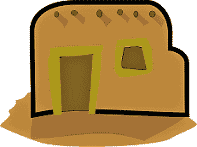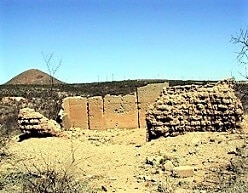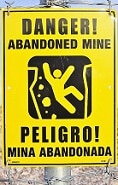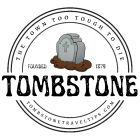The Brunckow Cabin takes its place in early Tombstone history. It was actually where the first true Tombstone Mine was sunk. Even though others get the official publicity and credit.
We’ve passed its namesake road many times, when driving to Sierra Vista for some shopping. We’ve discussed the town’s history with locals, and with people who have mentioned hiking to this Brunckow cabin area. Plus we have read historical books which mention it.

So our curiosity got riled up! That is why we wanted to look further into these mysterious ruins.
We’ll tell you its story. Read it Now>
What happened there will send chills up and down your spine! Because of all that happened. Like a Ghost Town, it is said to be haunted! More Here>
And we will tell you how to get there. It’s about nine miles out (south from town) of Tombstone. Right Here>
Brunckow Cabin History
Frederick Brunckow
It all began with Prussian-born Frederick Brunckow, an honors graduate of Berlin’s Royal Mining Academy. With some practical European gold and silver mining experience, he immigrated to Texas in the mid 1850s.1
In 1856 he came to Tucson Arizona, employed by Sonora Exploring and Mining Company.3 By 1857 as their Field Geologist, was sent to investigate areas East of the Huachuca Mountains. He noted mineral evidence in the San Pedro River Valley.1
By 1859 Brunckow created his own venture, the St. Louis Mining Co. He recruited partners James Williams, a machinist, his brother William, and chemist J.C. Moss. They hired mine laborers out of Sonora, Mexico.

Their company started out successfully. They opened a ground shaft and built an adobe furnace for silver ore production. They built adobe homes for himself,6 for workers and their families, about 20 people. And built a store, completing this small village.1,6
Brunckow’s Employees Turn on Him
The Sonoran mine laborers violently revolted on July 23, 1860. They killed Brunckow, plowing a rock drill into his gut and throwing him down the mine shaft.1 William had gone for supplies at Fort Buchanan, forty miles away. Upon returning, he discovered Moss & James Williams dead, in a store-room. But the cook, David Bontrager, was missing.6

In terror, William Williams quickly returned to Fort Buckanan. Troops were sent to the Brunckow Cabin to investigate. They buried the bodies in unmarked graves. Ravaged likely by coyotes, possibly by wolves which were in that area in those days.

Motivation for the Brunckow Cabin Slaughter?
David Bontrager suddenly reappeared, after being released 30 miles south of the border. He explained he was captured by the Mexican laborers.6 But they finally released him because he was Catholic. At first though, the soldiers held him under suspicion in the murders.1
Fort Buchanan officers contacted Mexican authorities, who investigated the incident. They confirmed Bontrager’s story and were able to return some stolen equipment.1 The culprits were never arrested.6 Bontrager was released.1

Why did Mexican workers, with families, suddenly turn on their employer? The historical documentation sheds some light, but conjecture also lends some variable hints at motivation:
- In 1854 the Gadsden Purchase was completed, ceding this area from Mexico to the U.S. as a territory. The border suddenly crossed Mexicans living in that area. Maybe some were not agreeable to that, and the irritation built.
- This Brunckow claim was reported/alleged to have actually been first discovered by Mexicans miners in 1855.
- When Brunckow worked for Sonora Exploring and Mining Company he earned a yearly salary of $1800, quite high for those days. Upon starting his own company, was he so ambitious that he became the type to use and abuse his laborers? [But not according to U.S. news reports of the day.] Yet, consider the old time traditional song: “I owe my soul to the Company Store” which tells that type of story.
- Of course there was property there for the taking – likely some ore available. The Fort Buchanan commander received a message by courier from the investigating Sonoran commandant. It stated one of the culprits had been inebriated in the cantinas, spending away, bragging of the misdeed.1 Although an agreement for return of the offenders was possible, nothing came of it.


Only the Beginning of
Brunckow Sordid History!
No one continued the mining operation immediately afterwards.1 It was rumored that the Brunckow cabin became a meeting point for smugglers.3
Interestingly an 1880s Arizona Territory census information documented three Hispanic laborers as residents there. They stated they moved from New Mexico, but the interview wasn’t completed. It was scheduled for a return visit. It was never done.2

Milton A Duffield Brunckow Claim
Milton A. Duffield was a real estate speculator, who’d first come West in the California gold rush of 1849. Ended up in Arizona, and was appointed its first U.S. Marshall when it became a U.S. Territory. Holding that position about 2-1/2 years. A large man, known as a nasty, hard drinker who liked to show off his macho muscles and gunplay.1
He picked up real estate around Southern Arizona, apparently acquiring claim to the Brunckow Mine. But he had lots of creditors. To protect his interests, he transferred his Brunckow mine ownership to his housekeeper. It was registered to Mrs. Mary E. Vaughn.
Edward N Fish Also Makes a Claim!
Edward N. Fish was a merchant, who invested in land with others. This group made claim to the Brunckow cabin and mine. Fish sent his employee, Joseph Holmes, to the mine to reside in one of the adobe cabins.
On June 5, 1874 Duffield decided to ensure his claim. He’d made it known he’d kill anyone trying to impinge on his mine claim. But unarmed, Duffield entered the cabin. Holmes killed Duffield with a shotgun.

Duffield was buried near the others killed there, in an unmarked grave.1 Holmes was found guilty of voluntary manslaughter. Imprisoned, he escaped after 17 days! He wasn’t pursued, never held accountable.
Soon thereafter, Mary Vaughn thought to exercise her claim to the property. She posted a trespass notice and publicized her Pima County filing. She was pressured to give it up. She gave in, vacating the claim. Fish also was exposed to public pressure and didn’t pursue his claim.
The Fifth or Sixth (?) Brunckow Claim
A Tucson resident, who gathered great power and wealth since coming out West, was the next Brunckow claimee. In late 1875, Sidney R. DeLong filed a relocation notice with two partners: N.M. Rogers and Tom Jeffords. This enabled them to get title to the property.
They began working the mine, employing laborers. Rogers was subsequently killed by Apaches, as were 2 others in nearby Valleys in other incidents. Apache attacks interrupted mining in that area. DeLong also then developed mining interests in Dos Cabezas Arizona. Closer to Fort Bowie protection.
DeLong’s Brunckow claim was still being worked as late as 1877, when Ed Schieffelin began surveying the Tombstone area. In August of that year, Ed wanted ore samples evaluated from 2 of his first 3 area claims: Graveyard 1 and Graveyard 2. He brought them to DeLong for his opinion.
DeLong wasn’t asked to go in with Schieffelin on his claims. But his somewhat impertinent assessment was that the ore was “very low-grade” and he “had all the mines he wanted.”4
By May 1878, DeLong was gone. He abandoned the claim and the buildings, although still holding title. Others subsequently came, making use of the cabins. The stories continued…
Ghostly Reputation of the Brunckow Cabin

Already we’ve learned about terrible killings there. Occurring not too long after the cabin area was first built and mining began. Frederick Brunckow found murdered, along with his two associates. They were buried there. Another kidnapped.
Then as a result of an ownership dispute, Milton Duffield was also killed and buried on the property.
Ghost Stories Thru the Years…

These events didn’t escape notice of Arizona Territory residents. Newspapers built on this reputation and noted rumors of strange phenomenon reported in the area of the Brunckow Cabin. Newspaper accounts told readers about many other killings there. They revealed these happened in this area between 1860 and 1881, as many as 17 more!5
A May 20, 1881 issue of Prescott’s Arizona Democrat wrote about the multiple burial sites that could be found in the cabin’s surroundings. The reporter recalled that miners stated they passed up prospecting in the Brunckow site. They’d heard of agonized ghostly apparitions haunting the cabin and grounds.
A May 1897 local Tombstone paper published a story about the Brunckow Cabin. It outlined how a bunch of thieves robbed a Wells Fargo stage. They went to the cabin and began fighting over division of their loot. These robbers went so far as a gunfight, and were all found dead inside the building. Wells Fargo recovered the stolen gold.
The newspaper writer then spoke of reported hauntings:
- A ghost haunts Brunckow Cabin, appearing & disappearing when someone goes toward it – then reappearing elsewhere
- Mining equipment sounds are heard on occasion – drills and axes working the ledges, wood being cut with saws
Author Joshua Hawley’s 2010 book Tombstone’s Most Haunted (currently out of print) outlined his own experience on-site, adjacent to the cabin. With ghost hunting research equipment he recorded a faint voice he made out to say “My girlfriend” or maybe “My good friend.”
His book also reports on hauntings experienced by others at the Brunckow Cabin. For instance, one person took a photo of the cabin, in which appeared a bluish highlighted ghostly figure.
Such is the reputation of the Brunckow Cabin, from its 1800s history until now! The ruins are deteriorating year by year.6 Everyone that goes there says, better check it out before the whole area turns back into desert sand!
Do you want to try it?
Hike to Brunckow Cabin & Mine

If you locate Brunckow Road, you may think it’s a way you can drive to the Brunckow Cabin. Not!
Turn onto Brunckow Road, look up ahead, over to the left. You’ll immediately see there’s a sign posted as Private Property. The road leads to an administrative area and residences. That road leads to private land. You cannot drive along it. But…

tips To find the Brunckow Cabin
The Brunckow Cabin is further West from where Brunckow Road turns off from Charleston Road.
- From Tombstone town, take East Allen Street, make a left turn onto Sumner Street, and it automatically turns into Charleston Road.
- Located on BLM land, so that is not private property. Use a different access than driving down along Brunckow Road
- If you have a GPS, map coordinates are: N 31 38.315 W 110 09.452
- Once you begin your hike, expect about a 1/3 mile go, from just off Charleston Road where you’ll park
- BLM officials say the site is approved for hiking into, and parking. As long as you stay on BLM land
Easiest Direct Brunckow Cabin Hikes
Pull into Brunckow Road. Just into it, look to the right. You’ll see a graveled area right inside the fence where you can park.
First Hike Option:
- Walk along Brunckow Road, even past the warning sign. It’s okay to walk here – it’s BLM land. Car travel is prohibited.
- Walk about one-tenth mile, until you see a break in the fence with a big sandy opening.
- Turn right into this area when a trail begins. Take this trail.
- Soon on the right-hand side you’ll pass another set of ruins – this isn’t the Brunckow Mine! Not sure what they are – we’ve not investigated this one! And it’s not as ancient. Keep on.
- In about 1/4 mile or a little less, you’ll cross a major wash. Go directly across, where the trail enters a bit more vegetative, uphill area.
- Right ahead of you, you’ll now see the Brunckow Cabin ruins.
Second Hike Option:
- Begin heading West past the parking area, on a vague trail that parallels Charleston Road.
- You’ll see 3 telephone poles, just before the 3rd one, another vague trail jogs off to the left. Take that one.
- Eventually this trail widens out, becoming a small wash, and will cross over another wash.
- Shortly thereafter it splits. Take the left fork.
- In not too much farther you’ll enter a large wash. Follow this to the left.
- As you look to your right, the Brunckow Cabin ruins will be up over the edge of the wash. Find an access point. There is a relatively easy one down a little ways on the right.
Back-country camping is allowed here – a permit is required. Most people have been camping here when reportedly seeing historic Haunted Tombstone area apparitions!
A few cautions if you plan to take this hike!
- Check The Weather! If there is any chance of storms – winter storms, or especially Arizona Monsoon thunderstorms, postpone this hike. Some washes are encountered. One particularly large, and flash-flooding waters could endanger you!
- Remember this is the Chihuahuan Desert. No matter the time of year, have enough water with you. If it’s summertime, consider if this hike is a wise idea! If temperatures are in the Fahrenheit high 90s or into the 100 range, hiking is not generally advised. Listen for cautionary news/weather reports!
- Be vigilant about old mine shafts – quite a few are around. Always watch your surroundings and where you’re walking. One mine claim after another was located over these Tombstone Hills! Often fenced off. But, do not ever try to enter them, whether fenced or not.


- Always watch for venomous animals. Most will not attack you – scorpions, spiders, rattle snakes, etc. Rattle snakes may surprise you with a warning. Attacks sometimes occur, but are rare. They will try to warn you. Just walk with awareness of your surroundings. Back away if you see one. They really do not want to attack you.
- Personal experience: I encountered a Diamondback Rattle Snake on a trail way back, in the desert area of the Rincon Mountains. Let’s see, it was 1988 I believe. It crossed right in front of me, and rattled. I was very startled, and slowly backed away. It moved off the trail. Probably as glad to get away from me, as I was to have it get away from me!! That’s the only time I’ve seen one while hiking, all these years.
- Gila Monsters will do their best to stay out of your way. They’re typically not out and about in the light of day. If you happen to spot one, just back off and give them a wide berth. Gila Monsters are protected – they must be provoked to attack, anyway. So please, just leave them alone. Watch them move away from you from a distance. It’s against the law to harm them.

Helpful Pamphlet for Hiking the Area:
References
1 Egerton, K. (1979, Sept. 23). Cross the bridge and hear the phantoms shriek. que pasó? Pp. 371-372. Phoenix: Arizona Republic.
2 Lainhart, A.S. (1992). State census records. Genealogical Publishing Company Inc., Baltimore.
3 Kuehlthau, M. (1965, Feb. 15). 17 Died violently at old Brunckow cabin. P. 12. Tucson Daily Citizen.
4 Underhill, L. (1979, Spring). The Tombstone discovery: The recollections of Ed Schieffelin and Richard Gird. Arizona and the West, Vol. XXI
5 Treat, W. (2007). Weird Arizona: Your local guide to Arizona’s local legends and best kept secrets. New York: Sterling Publishing Co. Inc.
6 Stinson, S. (1978, June 26). Site of violent death ages quietly in the sun. Tucson: The Arizona Daily Star.

I plan on visiting the Brunckow Cabin in early November. I and my co-author are writing our second book “Haunted Mining Towns of Arizona” and want to include Brunckow. I would like to go and take my own pictures and also do a small investigation to see if we get anything on our recorders and cameras. It will be during the late afternoon, not during the night.
Any advice you can give? Although your writeup is very helpful and give a lot of information. I just want to make sure we are not trespassing.
Thank you,
Darlene
Hi Darlene, glad you liked the writeup. You should have no issues since the area is on Bureau of Land Management land. Just look out for mineshafts and Gila monsters and you’ll be safe!